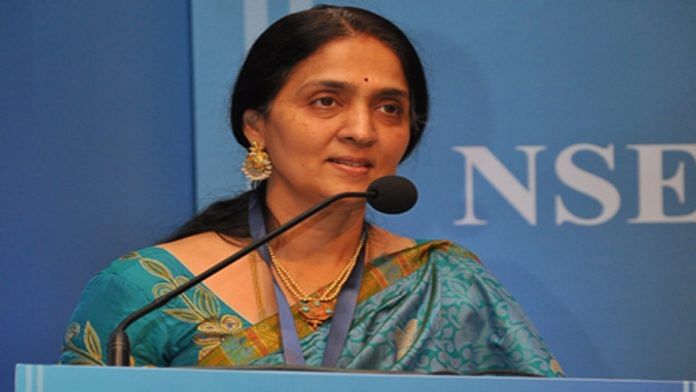New Delhi: Once known as the “queen of the bourses”, Chitra Ramkrishna is now a subject of ridicule amid a scandal that reflects gross misgovernance at India’s leading bourse, the National Stock Exchange (NSE).
Last week, an order from stock market regulator Securities and Exchange Board of India (SEBI) stated that Ramkrishna shared sensitive information regarding the business of the NSE with an unknown and an unidentified person, who dwells in the Himalayas. She claimed she had been taking advice from this individual — a ‘yogi’ who she had allegedly never met — for the last 20 years while making business decisions.
This was followed by income tax department raids early Thursday at premises linked to her in Chennai and Mumbai on the basis of “credible information of tax evasion”.
Ramkrishna was the managing director (MD) and chief executive officer (CEO) of NSE between 2013 and 2016. What is baffling in her story, and unbecoming of a securities law expert, is that she is one of the guiding forces who designed the regulatory framework for setting up SEBI in the country, but herself was guided for several years by a ‘yogi’ who she claims does not possess a material form and can manifest at will.
In her defence, Ramkrishna had said that senior leaders often seek informal counsel from coaches, mentors or other seniors in this industry which are all purely informal by nature. In a similar strain, she felt that guidance from this spiritual force would help her perform her role better.
Ramkrishna could not be reached for comment. This article will be updated if she can be reached.
Also Read: SEBI seeks tighter environmental, social & governance rules to address risk of greenwashing
Fall from power
Starting her career as a chartered accountant with the Industrial Development Bank of India (IDBI) in the 1980s, Ramkrishna made headway into becoming one of the key persons who set up the NSE, which was born as an alternative to the Bombay Stock Exchange, now BSE Limited, after the Harshad Mehta scam, and as part of government’s efforts to ensure transparent trading.
Ramkrishna, 59, is the third woman to head an exchange in the Asia-Pacific region after Sri Lanka’s Colombo Stock Exchange and China’s Shenzhen Stock Exchange, and had been part of NSE’s explosive growth since its inception.
A lover of Carnatic music with a passion for the veena, Ramkrishna never invested in stocks but got interested in the stock market when she started working on building the legislative framework for SEBI. She had been instrumental in pushing the government to invest the corpus lying with the Employee Provident Fund Organisation in stock markets, which the government later did.
According to financial news portal Moneycontrol, which quoted an NSE insider, Ramkrishna appeared to be a polite, smiling and simple person, but those who knew her well, knew that she could also be shrewd and resourceful. Moreover, she had deep connections in the national capital. The same insider said Ramkrishna would come to know if someone from the NSE’s top management visited the power corridors of Delhi.
Having won several awards, Ramkrishna was named Forbes’ ‘Woman Leader of the Year’ in 2013. She was also appointed chairperson of the Board of World Federation of Exchanges, a global industry association for exchanges and clearing houses, in 2016.
She called Mahatma Gandhi her role model and wanted to make stock markets accessible to India’s middle classes using the exchange-traded baskets of securities known as ETFs. ETFs are pooled investment funds just like mutual funds.
Despite her profession being heavily dominated by men, Ramkrishna was one of the highest paid executives in the financial services industry, earning Rs 9.7 crore annually, before she quit the NSE in 2016.
While she was involved in most of the core advancements of business within NSE, she is most known for setting up a pan-India VSAT (very small aperture terminal) network, two-way satellite ground station with dish antennas to efficiently transmit and redirect data in real-time, which improved trading in securities.
In March 1995, the NSE had 135 companies and the daily average turnover for equities was Rs 17 crore. Today, it has over 7,500 companies listed and the average daily turnover in the cash segment has grown to over Rs 60,000 crore.
It was smooth sailing for Ramkrishna until 2015, when a trading scam broke out at the bourse. A Singapore-based whistleblower complained to the market regulator that NSE had given preferential access of their servers to some high-frequency traders by placing their servers closer or linking them to NSE’s. This would result in faster access to prices by these traders. And all of this happened under Ramkrishna’s nose. This is when things started going south.
A SEBI panel was formed in 2016, which found merit in these allegations and started an investigation into corporate misgovernance at the NSE. Ramkrishna has been away from public life since the day she resigned in December 2016.
At the end of the day, Ramkrishna might just be able to recoup her losses but the institution that faced the brunt of her blind belief may struggle to regain its credibility for a long time.
(Edited by Gitanjali Das)
Also Read: Two telecom lines failed to protect NSE, world’s top derivatives exchange






